Brabham is the common name for Motor Racing Developments Ltd., a British racing car manufacturer and Formula One racing team. Founded in 1960 by Australian driver Jack Brabham and British-Australian designer Ron Tauranac, the team won four Drivers' and two Constructors' World Championships in its 30-year Formula One history. Jack Brabham's 1966 FIA Drivers' Championship remains the only such achievement using a car bearing the driver's own name.

Martini Racing is the name under which various motor racing teams race when sponsored by the Italian company Martini & Rossi, a distillery that produces Martini vermouth in Turin. Martini's sponsorship program began in 1958 as Martini International Club, founded by Count Metello Rossi di Montelera of Martini & Rossi. The race cars are marked with the distinctive dark blue, light blue and red stripes on white, red or silver background body cars. The car model which has won the most titles for Martini Racing is the Lancia Delta HF Integrale.
Ian Gordon Murray, is a South African-British designer of Formula One racing cars for Brabham and McLaren and the McLaren F1 high-performance road car. Founder and CEO of Gordon Murray Design and Gordon Murray Automotive he has subsequently designed and built a number of sports cars and a variety of other automotive vehicles.

The 1974 Argentine Grand Prix was a Formula One motor race held in Buenos Aires on 13 January 1974. It was race 1 of 15 in both the 1974 World Championship of Drivers and the 1974 International Cup for Formula One Manufacturers. The 53-lap race was won by McLaren driver Denny Hulme after he started from tenth position. Niki Lauda finished second for the Ferrari team and his teammate Clay Regazzoni came in third.
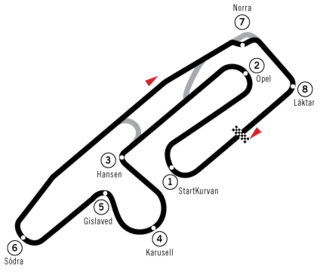
The 1975 Swedish Grand Prix was a Formula One motor race held at the Scandinavian Raceway at Anderstorp on 8 June 1975. It was race 7 of 14 in both the 1975 World Championship of Drivers and the 1975 International Cup for Formula One Manufacturers. It was the sixth Swedish Grand Prix after it was first held as the Swedish Summer Grand Prix in 1933, and the third to be held at Scandinavian Raceway. It was held over 80 laps of the four kilometre circuit for a race distance of 322 kilometres.

The 1975 British Grand Prix was a Formula One motor race held at Silverstone on 19 July 1975. It was race 10 of 14 in both the 1975 World Championship of Drivers and the 1975 International Cup for Formula One Manufacturers. It was the 30th British Grand Prix to be held since the race was first held in 1926 and the 17th time the race had been held at Silverstone. The race was held over 56 of the scheduled 67 laps of the four kilometre venue for a race distance of 264 kilometres.

The 1975 German Grand Prix was a Formula One motor race held at Nürburgring on 3 August 1975. It was race 11 of 14 in both the 1975 World Championship of Drivers and the 1975 International Cup for Formula One Manufacturers. It was the 37th German Grand Prix and the 34th to be held at the Nürburgring. The race was held over 14 laps of the 22.8-kilometre (14.2 mi) circuit for a race distance of 319 kilometres (198 mi).
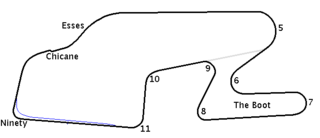
The 1975 United States Grand Prix was a Formula One motor race held on October 5, 1975, at the Watkins Glen Grand Prix Race Course in Watkins Glen, New York. It was race 14 of 14 in both the 1975 World Championship of Drivers and the 1975 International Cup for Formula One Manufacturers. It was the 25th United States Grand Prix since the first American Grand Prize was held in 1908 and the 18th since the first United States Grand Prix at Riverside in 1958.
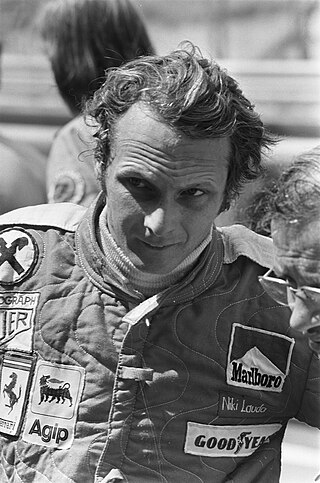
The 1975 Formula One season was the 29th season of FIA Formula One motor racing. It featured the 1975 World Championship of F1 Drivers and the 1975 International Cup for F1 Manufacturers which were contested concurrently from 12 January to 5 October over fourteen races. The season also included three non-championship Formula One races and a nine race South African Formula One Championship.
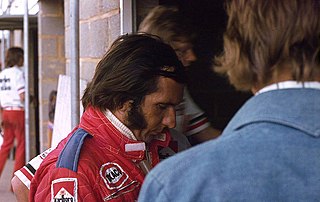
The 1974 Formula One season was the 28th season of FIA Formula One motor racing. It featured the 1974 World Championship of F1 Drivers and the 1974 International Cup for F1 Manufacturers, contested concurrently over a fifteen-race series which commenced on 13 January and ended on 6 October. The season also included three non-championship races.

José Carlos Pace was a racing driver from Brazil. He participated in 73 Formula One World Championship Grands Prix, debuting at the 1972 South African Grand Prix. He won one race, achieved six podiums, and scored a total of 58 championship points. He also secured one pole position.

Frank Williams Racing Cars was a British Formula One team and constructor.

The Williams FW07 was a ground effect Formula One racing car designed by Patrick Head, Frank Dernie, and Neil Oatley for the 1979 F1 season.

Carlos Alberto "Lole" Reutemann was an Argentine racing driver who raced in Formula One from 1972 to 1982, and later became a politician in his native province of Santa Fe, for the Justicialist Party, and governor of Santa Fe in Argentina.
Rondel Racing was a British racing team that competed in the Formula Two series between 1971 and 1973. The team was founded by two ex-Brabham mechanics Ron Dennis and Neil Trundle. Rondel won five European Championship races before being forced to close down in 1973 due to a number of factors including lack of money, loss of Motul support and NatWest Bank calling in a £5,000 overdraft over a workshop floor installed by Dennis.
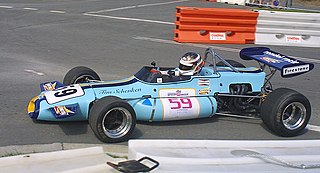
The Brabham BT36 was an open-wheel Formula 2 race car, designed by Ron Tauranac, and developed and built by British racing team and constructor, Brabham, for the 1971 European Formula Two Championship. Its best result that season was a 2nd-place finish in the championship for Argentine Carlos Reutemann, despite only winning one race, taking one pole position. His consistency and pace made up for this, scoring 6 podium finishes, and finishing the season with 40 points. The Brabham BT36 was constructed out of a complex tubular space frame, and was powered by the naturally-aspirated 1.6 L (98 cu in) Ford-FVA Cosworth four-cylinder engine, which produced 220 hp (160 kW), and drove the rear wheels through a 5-speed Hewland F.T.200 manual transmission.

The Brabham BT37 was a Formula One racing car designed by Ralph Bellamy for the Brabham team to use in the 1972 Formula One season. It was relatively unsuccessful compared to Brabham's earlier and later cars such as the BT19 or the BT44. In the 18 races it was fielded, it collected no wins, no pole positions and no fastest laps. The best results were two fourth place-finishes for Carlos Reutemann and Andrea de Adamich. It generally achieved poor qualifying results, the best being fifth for Reutemann on two occasions.

The Brabham BT45 was a Formula One car designed by South African engineer Gordon Murray for the 1976 Formula One season. In upgraded BT45B and BT45C form, it also competed in the 1977 and 1978 seasons.

The Brabham BT43 was the only Formula 5000 racing car built by Motor Racing Developments (MRD). Initiated by Ron Tauranac, designed by Geoff Ferris, and built by a team including Nick Goozee (monocoque) and Bob Paton (construction), it was one of the last cars produced by MRD before MRD was closed by the then new Brabham owner Bernie Ecclestone. Based on the Formula Two Brabham BT40 the BT43 featured a modified monocoque that incorporated the triangular cross section pioneered by the Brabham BT42 Formula One car which was designed by Gordon Murray. This distinctive pyramid shape not only kept the aerodynamic "stagnation point" low but also neatly allowed the incorporation of a "crushable structure" as required by the 1973 regulations which specified that all fuel tanks were to be protected by deformable structures. Engine and gearbox were the then de facto F5000 standard combination of a Chevrolet 302 cubic inch engine in an unstressed mounting and a Hewland DG300 gearbox. The fitment of these into what was a relatively small Formula Two sized car presented some design challenges. Front suspension components were BT40 while rear suspension components were a combination of Formula One and BT40.
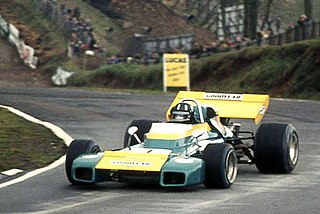
The Brabham BT34 was a Formula One racing car designed by Ron Tauranac, and used by Brabham during part of the 1971 and 1972 Formula One seasons.



















